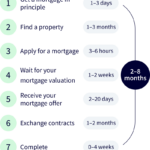Homebuyers and mortgage industry professionals alike have observed that the interest rate on home mortgages is considerably higher than the interest rate on long-term treasury bonds. Many are left wondering if the spread between the two will return to normal and if it does when that might happen. While it’s expected that the spread will eventually narrow, it’s unlikely to happen in 2023.
Understanding the Historical Spread Between Mortgage Rates and Treasury Bonds
Before the pandemic, the average spread between mortgage rates and 10-year treasury bonds was around 1.69 percentage points, typically ranging between 1.5% and 2.0%. However, the current spread is wider than historical standards, raising questions about when it might return to normal levels.

The Role of Mortgage Originators and Wholesale Mortgage Spread
Mortgage originators, such as brokers or banks, play a crucial role in determining the interest rate on home loans. They quote an interest rate to the homebuyer and then sell the loan to a government-sponsored entity like Fannie Mae or Freddie Mac. The mortgage originator is paid for this service by pushing the interest rate up, creating what is known as the retail mortgage spread.

When Fannie Mae or Freddie Mac sells a bundle of mortgages to investors, the interest rate is based on supply and demand. Investors generally view mortgages as inferior products compared to treasury bonds due to the option for homeowners to refinance their mortgages when rates drop. This refinancing option makes mortgage-backed securities a less attractive investment, so investors demand a premium over treasury bond interest rates, resulting in the wholesale mortgage spread.
Factors Affecting the Current Wide Spread
In early 2023, the wide total spread between mortgage rates and treasury bonds seems to be primarily due to the wholesale level. Bond traders point to interest rate volatility as the main factor. Rising interest rates mean fewer prepayments for mortgage-backed security owners while falling interest rates result in more prepayments when they’re least desirable. This prospect of interest rate changes in either direction drives investors away from mortgage-backed securities.

At the retail level, some spread widening can be attributed to the mortgage originator’s interest rate risk. In a more volatile interest rate environment, both retail and wholesale spreads increase. Over the last 52 weeks, the volatility of mortgage rates doubled compared to the preceding 52 weeks.
When Will the Wide Spread Return to Normal?
The key to the spread returning to normal lies in interest rate stabilization. This will likely occur after the Federal Reserve has completed its tightening phase and established a stable path for future interest rates. As of March 2023, more tightening is expected, with the possibility of the Fed dropping rates to stimulate the economy in 2024.

For homebuyers and homeowners considering refinancing, mortgage rates will likely begin to decline gradually starting in early 2024 and continue for about two years. The narrowing of the spread, when it occurs, will add further downward pressure to mortgage rates, making it an opportune time for home purchases and refinancing.



